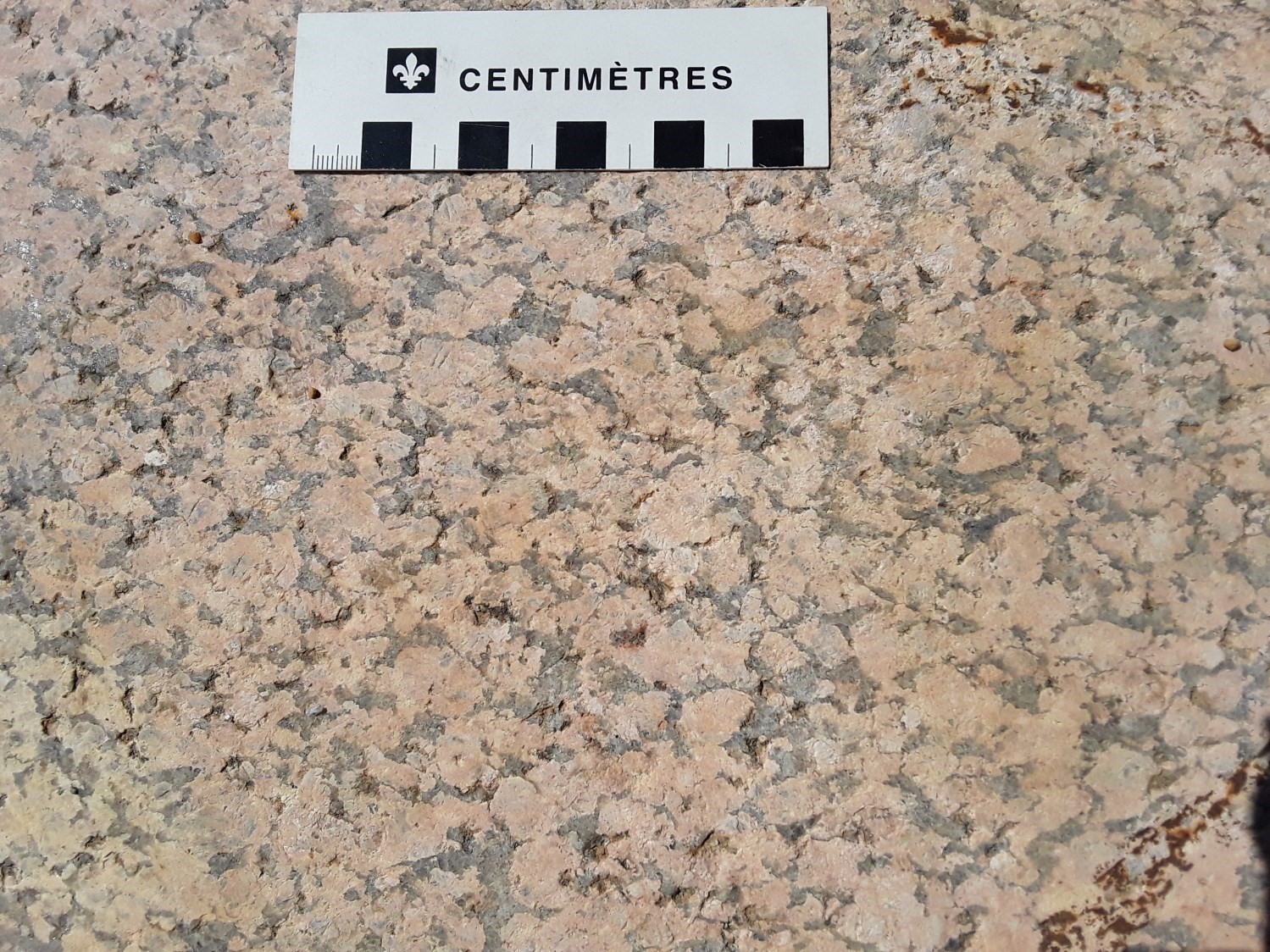
DISCLAIMER: This English version is translated from the original French. In case of any discrepancy, the French version shall prevail.
| Author(s): | El Bourki and Moukhsil, 2021 |
| Age: | Mesoproterozoic |
| Stratotype: | Reference outcrops 2021-AM-159 and 2021-FS-4030 |
| Type area: | Typical outcrops are located east and west of Tommy Lake (NTS sheet 32H01). |
| Geological province: | Grenville Province |
| Geological subdivision: | Allochton |
| Lithology: | Felsic to mafic plutonic rocks |
| Category: | Lithodemic |
| Rank: | Lithodeme |
| Status: | Formal |
| Use: | Active |
None
Background
The Tommy Intrusive Suite was defined by El Bourki and Moukhsil (2021) while mapping the areas north of Dolbeau-Mistassini (sheet 32H01), Girardville and Blondelas Lake (sheet 32H07), in the Saguenay–Lac-Saint-Jean region.
Description
The Tommy Intrusive Suite is a polyphase intrusion consisting of felsic, intermediate, mafic and ultramafic rocks divided into three informal units (mPtmm1, mPtmm2 and mPtmm3). The various phases of the suite are locally cut by a dyke of carbonatite and ultramafic rock, and also contain enclaves of leuconorite. The rocks of this suite are highly magnetic and easily identified on aeromagnetic maps (Intissar and Benahmed, 2015).
Tommy Intrusive Suite 1 (mPtmm1): Gabbronorite, alkali feldspar granite, syenogranite, leuconorite and mangerite; locally cut by a dyke of carbonatite and ultramafic rocks
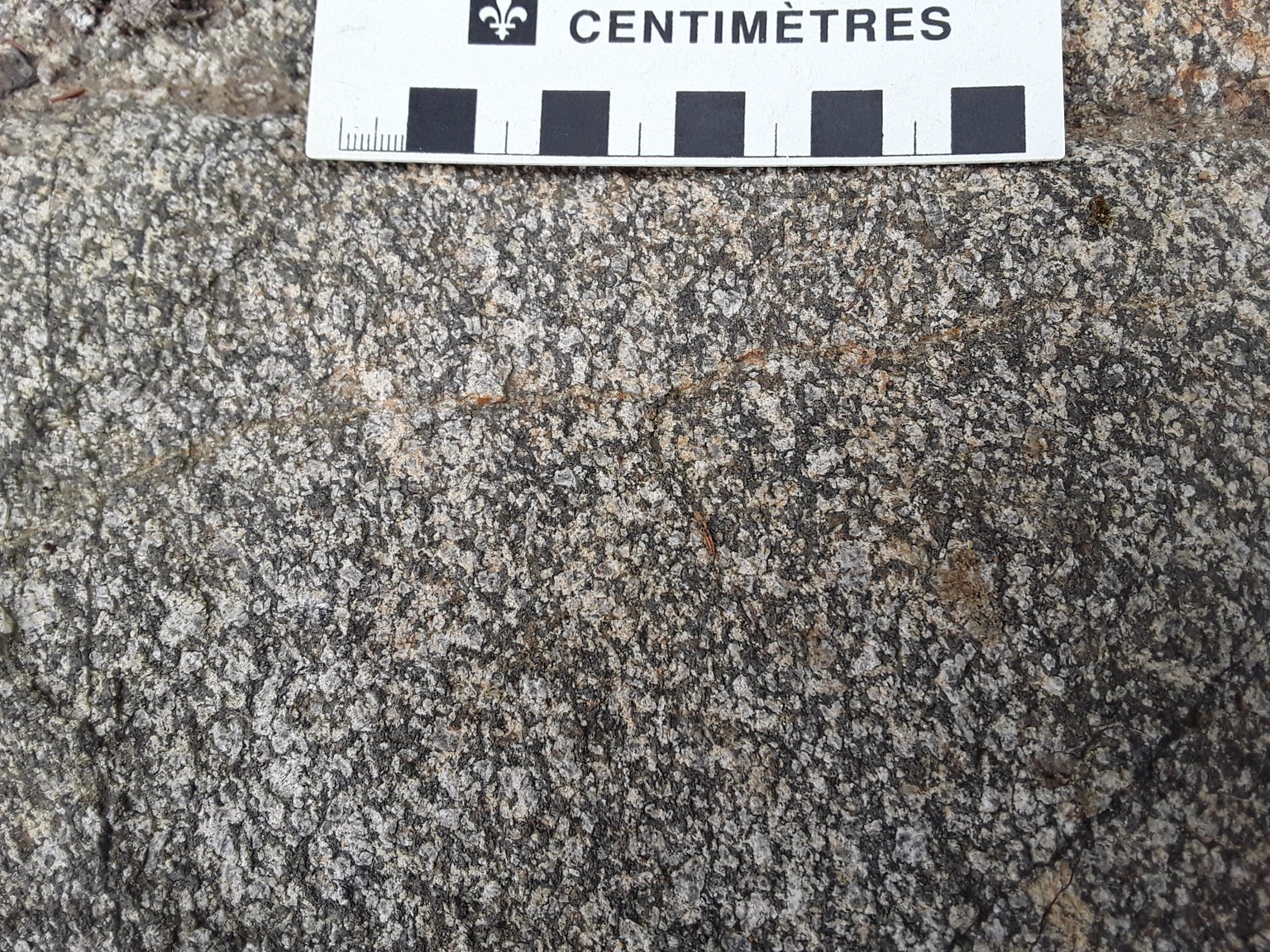
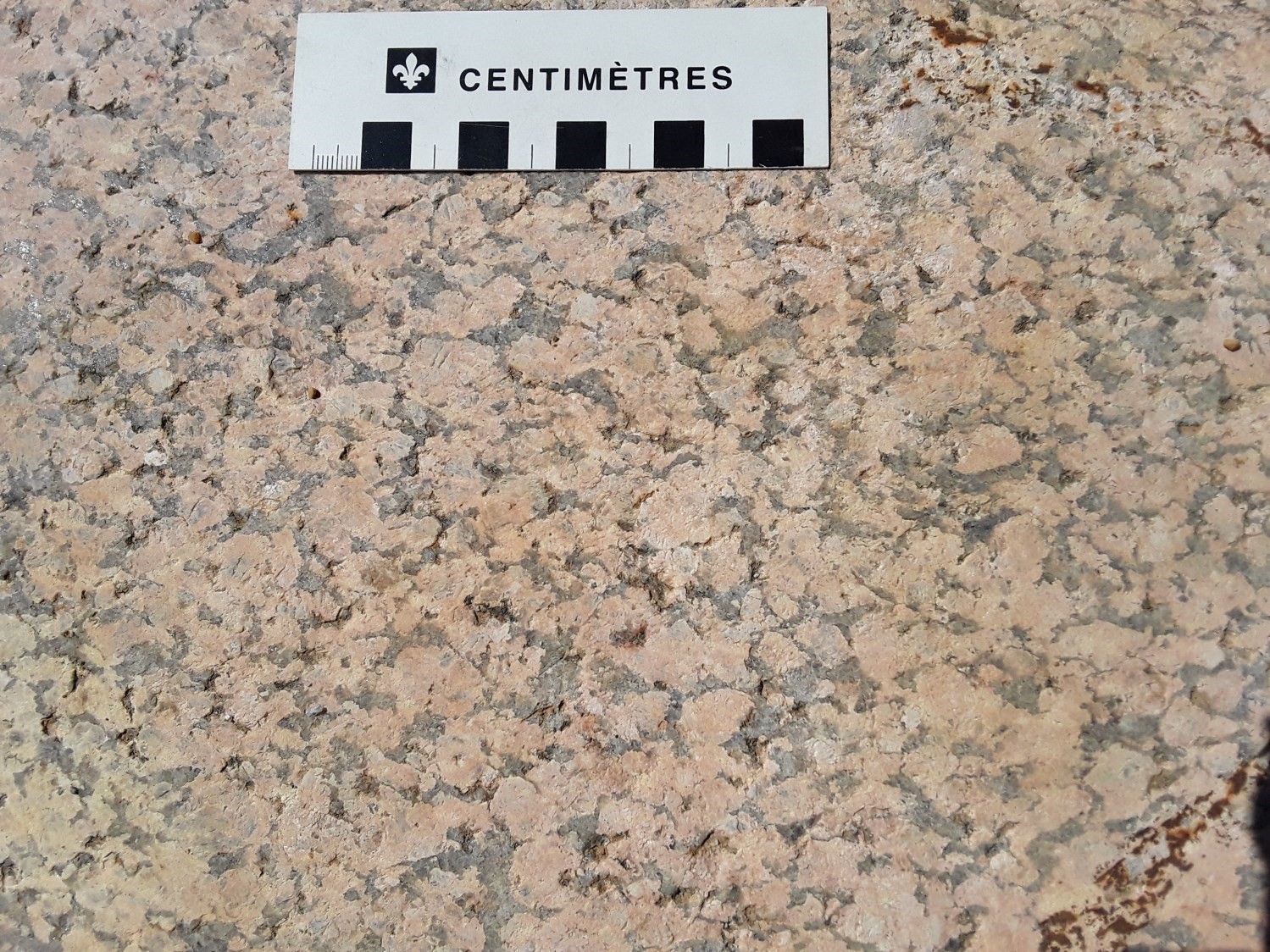
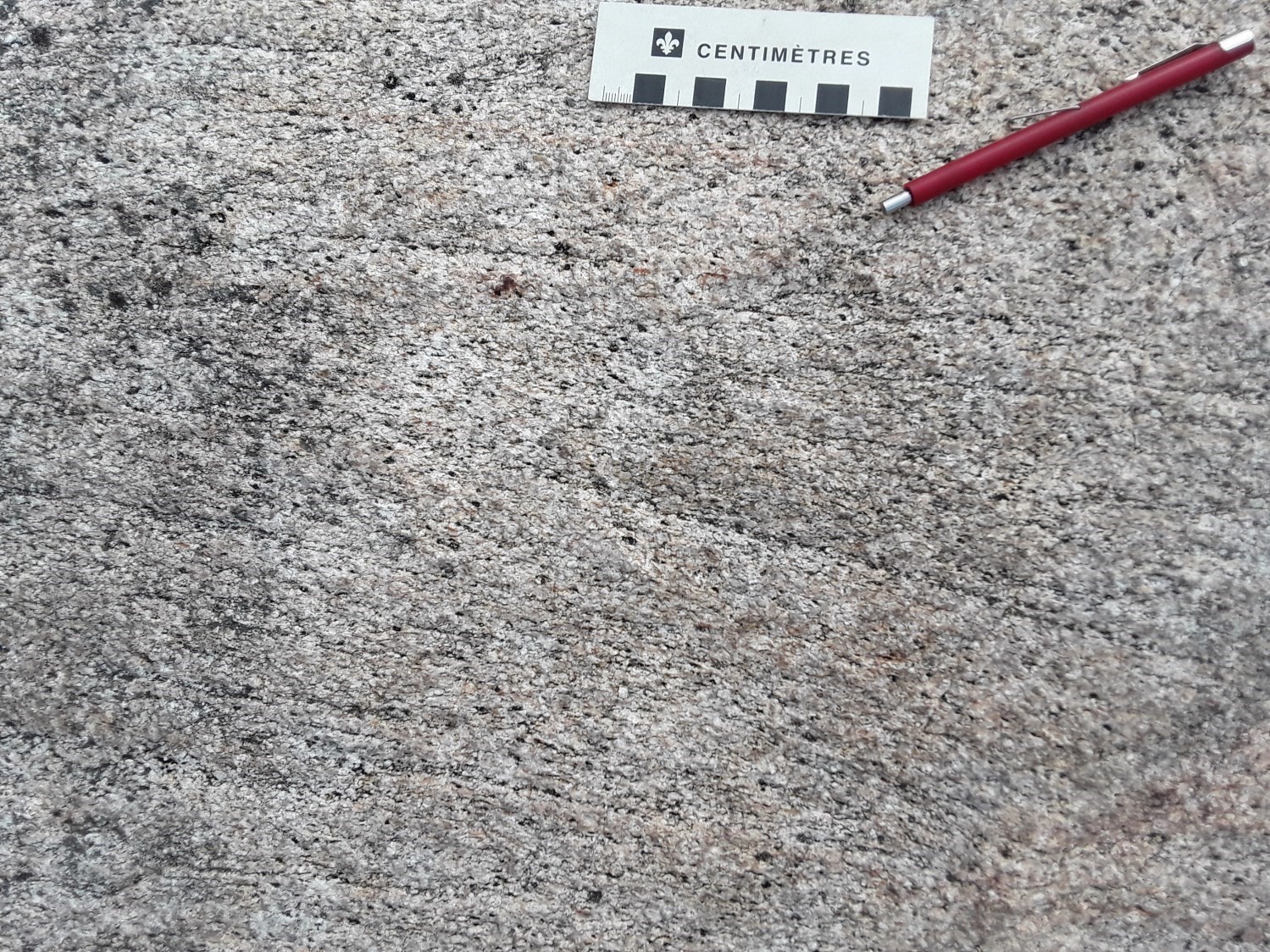 Gabbronorite is black-green in fresh surface and has a brownish to rusty-grey alteration patina. It is generally medium to coarse grained, granoblastic and foliated (e.g., outcrop 2021-FS-4034). Several outcrops of this gabbronorite are porphyroid with plagioclase phenocrysts, subophitic and locally gneissic (e.g., outcrop 2021-AM-159). The gabbronorite is composed of plagioclase, orthopyroxene, magnetite, biotite, clinopyroxene, apatite, ilmenite and traces of amphibole and disseminated millimetre-sized sulphides (pyrite, pyrrhotite). The alkali feldspar granite (e.g., outcrop 2021-FS-4030) is pink-white in altered and fresh surfaces. It is coarse grained to porphyroid with potassium feldspar phenocrysts and foliated. Under the microscope, the pinkish potassium feldspar phenocrysts are perthitic and associated with myrmekite. These are 2 to 3.5 cm in length and can reach 65% of the rock. The other minerals are quartz in large patches and marked by undulatory extinction, plagioclase locally altered to sericite, biotite and magnetite. In the field, a variation in feldspar from one outcrop to another is noted; the alkali feldspar granite becomes a syenogranite. The latter is generally pink-grey in alteration patina, pink on the fresh surface and hematitized. It is fine to medium grained, locally mylonitic (e.g., outcrop 2021-FS-4082). Microscopically, it consists of perthitic and myrmekitic potassium feldspar, plagioclase altered to sericite, amphibole, biotite, magnetite and quartz. The latter is in a large patch and shows an undulatory extinction. Accessory minerals are apatite in inclusion in the biotite, epidote and zircon.
Gabbronorite is black-green in fresh surface and has a brownish to rusty-grey alteration patina. It is generally medium to coarse grained, granoblastic and foliated (e.g., outcrop 2021-FS-4034). Several outcrops of this gabbronorite are porphyroid with plagioclase phenocrysts, subophitic and locally gneissic (e.g., outcrop 2021-AM-159). The gabbronorite is composed of plagioclase, orthopyroxene, magnetite, biotite, clinopyroxene, apatite, ilmenite and traces of amphibole and disseminated millimetre-sized sulphides (pyrite, pyrrhotite). The alkali feldspar granite (e.g., outcrop 2021-FS-4030) is pink-white in altered and fresh surfaces. It is coarse grained to porphyroid with potassium feldspar phenocrysts and foliated. Under the microscope, the pinkish potassium feldspar phenocrysts are perthitic and associated with myrmekite. These are 2 to 3.5 cm in length and can reach 65% of the rock. The other minerals are quartz in large patches and marked by undulatory extinction, plagioclase locally altered to sericite, biotite and magnetite. In the field, a variation in feldspar from one outcrop to another is noted; the alkali feldspar granite becomes a syenogranite. The latter is generally pink-grey in alteration patina, pink on the fresh surface and hematitized. It is fine to medium grained, locally mylonitic (e.g., outcrop 2021-FS-4082). Microscopically, it consists of perthitic and myrmekitic potassium feldspar, plagioclase altered to sericite, amphibole, biotite, magnetite and quartz. The latter is in a large patch and shows an undulatory extinction. Accessory minerals are apatite in inclusion in the biotite, epidote and zircon.
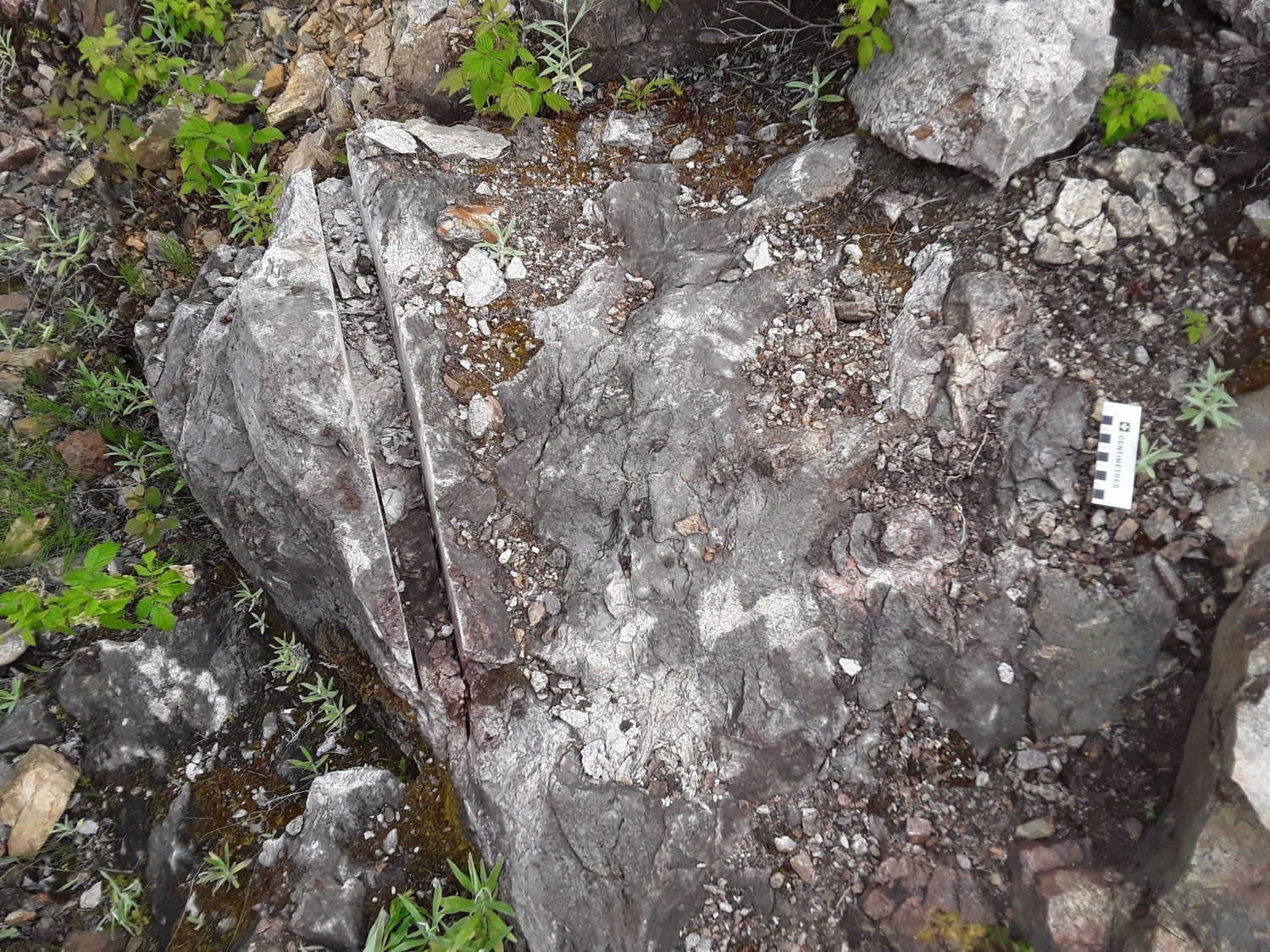
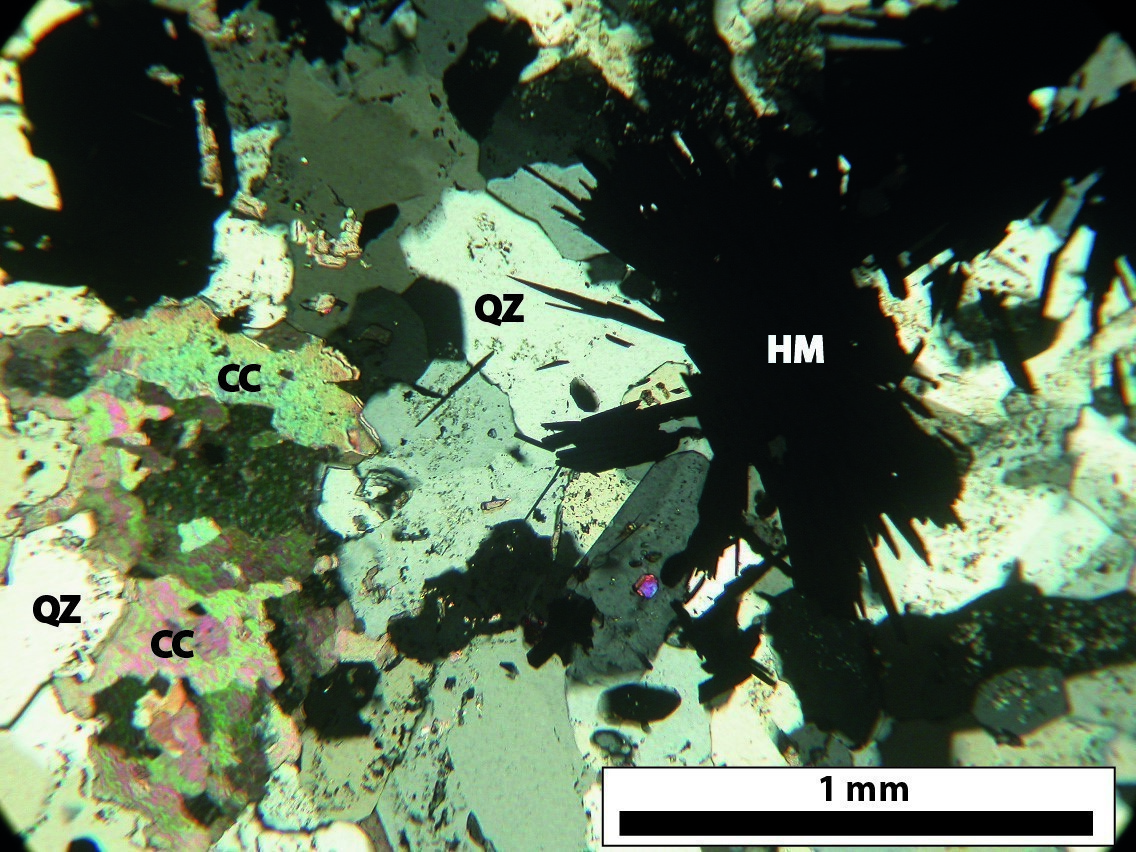
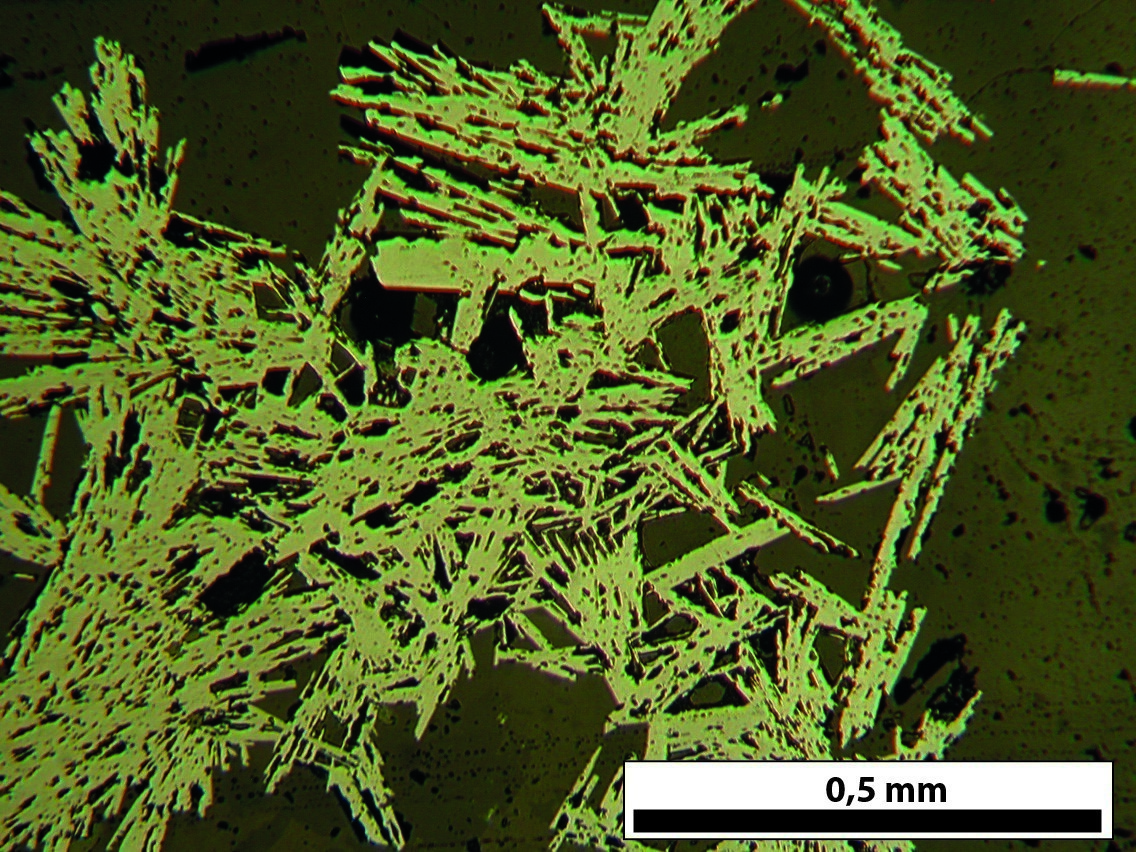 The syenogranite contains enclaves of fine-grained, foliated gabbro of 2-5 cm in thickness. It is cut by a carbonatite dyke. The latter is greyish in alteration patina, whitish in fresh surface and has a visible thickness of ≤5 dm (outcrop 2021-FS-4082, lithology D). The carbonatite is medium to coarse grained and compmosed mainly of calcite and apatite crystals with traces of biotite. The dyke hosts a rare earth element mineralization (Tommy Lake mineralized zone). The carbonatite dyke is associated with 1-2 dm thick veins of a rock grey-black in alteration patina and blue in fresh surface. This rock is intermediate in composition (58.72% SiO2), finely grained, rich in specular hematite in needle and/or fibre form and contains quartz, as wells as traces of calcite and apatite crystals. Another ~5 mm to 4 dm thick vein, rich in amphibole (arfvedsonite), with a comb structure is also observed in places in outcrop. This is associated with the syenogranite.
The syenogranite contains enclaves of fine-grained, foliated gabbro of 2-5 cm in thickness. It is cut by a carbonatite dyke. The latter is greyish in alteration patina, whitish in fresh surface and has a visible thickness of ≤5 dm (outcrop 2021-FS-4082, lithology D). The carbonatite is medium to coarse grained and compmosed mainly of calcite and apatite crystals with traces of biotite. The dyke hosts a rare earth element mineralization (Tommy Lake mineralized zone). The carbonatite dyke is associated with 1-2 dm thick veins of a rock grey-black in alteration patina and blue in fresh surface. This rock is intermediate in composition (58.72% SiO2), finely grained, rich in specular hematite in needle and/or fibre form and contains quartz, as wells as traces of calcite and apatite crystals. Another ~5 mm to 4 dm thick vein, rich in amphibole (arfvedsonite), with a comb structure is also observed in places in outcrop. This is associated with the syenogranite.

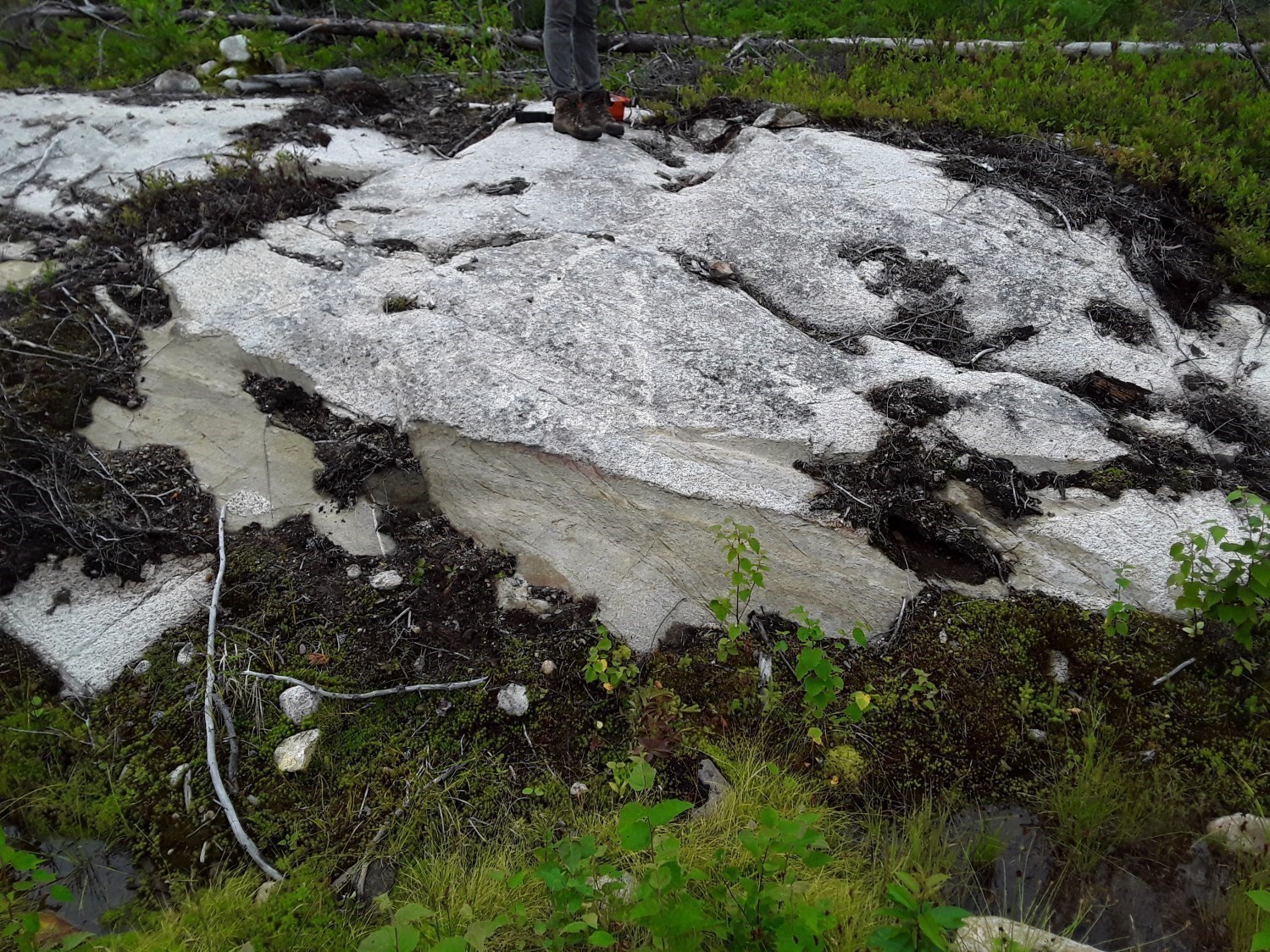 Leuconorite is a minority phase in terms of area in this suite (outcrop 2021-AM-160) and is grey-white in alteration patina, grey-beige in fresh surface and coarse grained to porphyroid with plagioclase phenocrysts. Leuconorite is magnetic and consists of orthopyroxene, clinopyroxene and biotite. A fine to very fine-grained lamprophyre dyke 0.2 to 1 m thick cuts the leuconorite. The lamprophyre consists of plagioclase, biotite, magnetite, clinopyroxene and contains centimetric enclaves of leuconorite.
Leuconorite is a minority phase in terms of area in this suite (outcrop 2021-AM-160) and is grey-white in alteration patina, grey-beige in fresh surface and coarse grained to porphyroid with plagioclase phenocrysts. Leuconorite is magnetic and consists of orthopyroxene, clinopyroxene and biotite. A fine to very fine-grained lamprophyre dyke 0.2 to 1 m thick cuts the leuconorite. The lamprophyre consists of plagioclase, biotite, magnetite, clinopyroxene and contains centimetric enclaves of leuconorite.
 Mangerite outcrops here and there north of unit mPtmm1 (e.g., outcrop 2021-GS-2157). It is brown-white in alteration patina and slightly greenish in fresh surface. The rock is fine to medium grained, locally porphyroid with phenocrysts of potassium feldspar, granoblastic and moderately deformed. The potassium feldspar phenocrysts constitute <2% of the rock and do not exceed 3.5 cm in length. The mangerite also contains quartz, plagioclase, orthopyroxene, magnetite and traces of clinopyroxene.
Mangerite outcrops here and there north of unit mPtmm1 (e.g., outcrop 2021-GS-2157). It is brown-white in alteration patina and slightly greenish in fresh surface. The rock is fine to medium grained, locally porphyroid with phenocrysts of potassium feldspar, granoblastic and moderately deformed. The potassium feldspar phenocrysts constitute <2% of the rock and do not exceed 3.5 cm in length. The mangerite also contains quartz, plagioclase, orthopyroxene, magnetite and traces of clinopyroxene.
Tommy Intrusive Suite 2 (mPtmm2): Quartz monzodiorite and monzodiorite
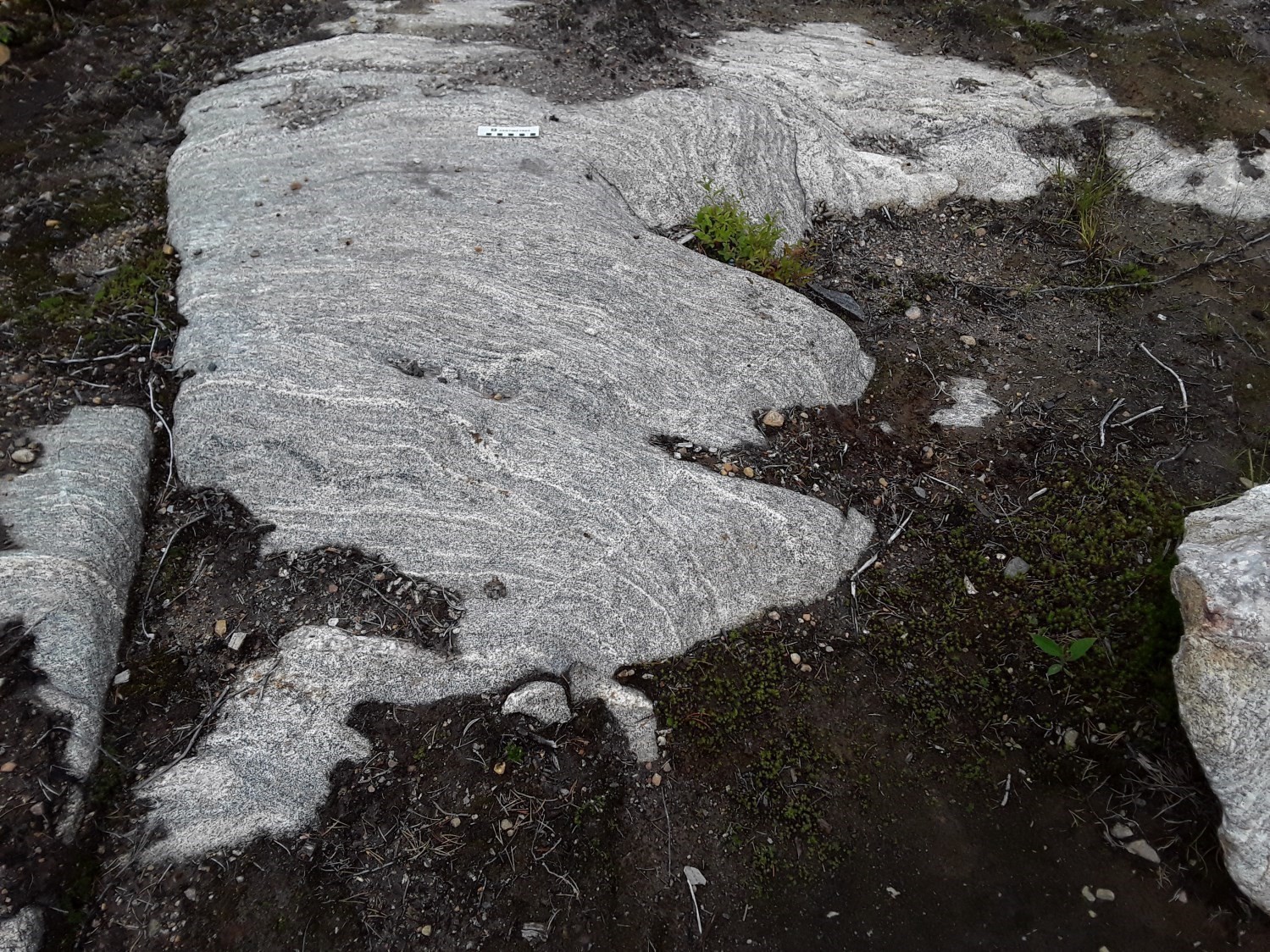
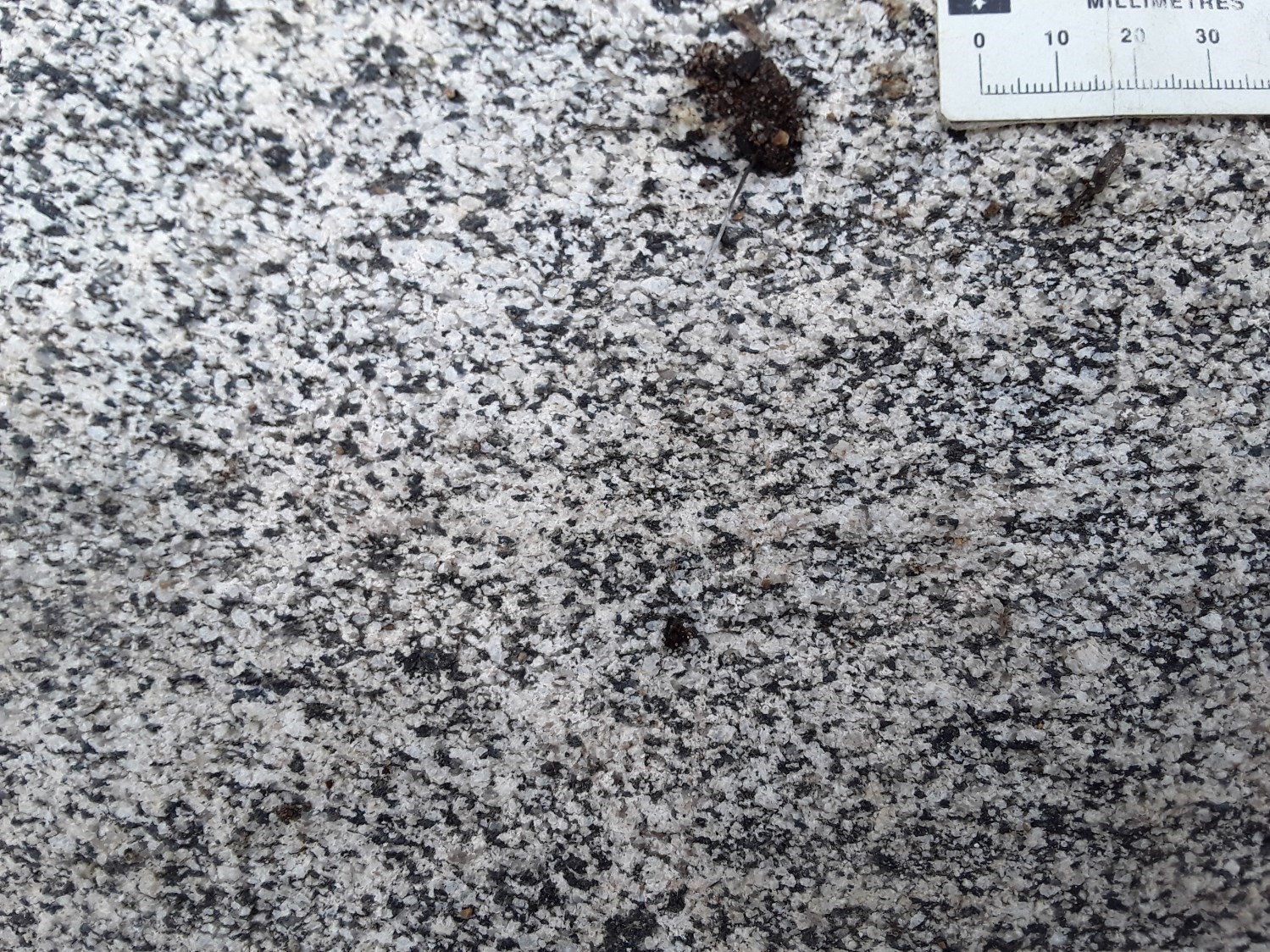 The quartz monzodiorite is grey-white in alteration patina, grey-white in fresh surface, medium to coarse grained, granoblastic and foliated. The rock consists of quartz, plagioclase, biotite, clinopyroxene, magnetite, traces of potassium feldspar and, locally, some orthopyroxene grains. It is less deformed than monzodiorite and is cut by veins and veinlets of granitic composition.
The quartz monzodiorite is grey-white in alteration patina, grey-white in fresh surface, medium to coarse grained, granoblastic and foliated. The rock consists of quartz, plagioclase, biotite, clinopyroxene, magnetite, traces of potassium feldspar and, locally, some orthopyroxene grains. It is less deformed than monzodiorite and is cut by veins and veinlets of granitic composition.
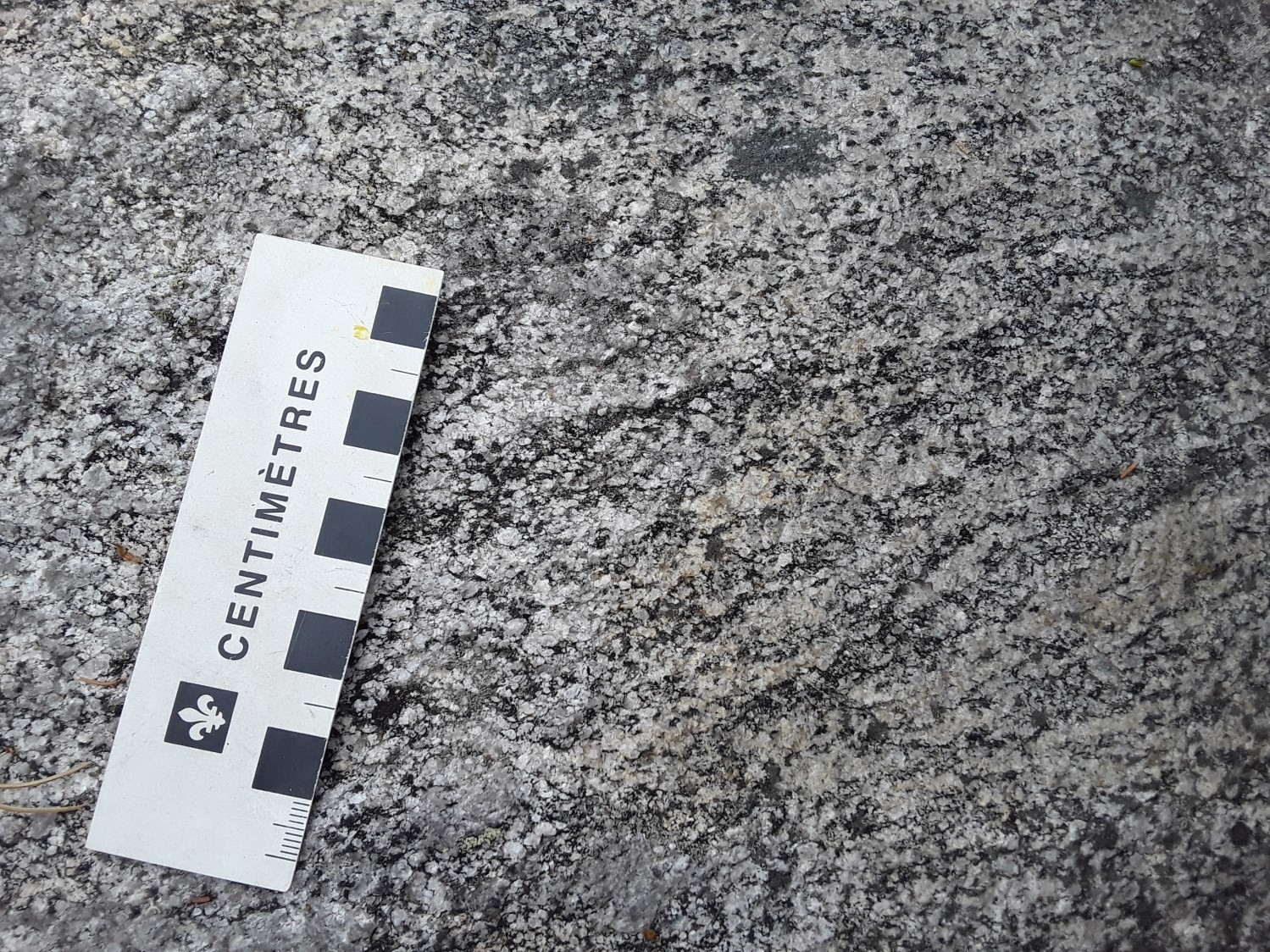 The monzodiorite is greyish in alteration patina, olive-grey in fresh surface, medium grained and foliated (e.g. outcrop 2021-FS-4087). It consists of amphibole, biotite, magnetite and clinopyroxene. A few occurrences of pink granite have also been observed in this unit. The rock is medium-grained, foliated and consists of quartz, feldspar, amphibole, biotite and magnetite.
The monzodiorite is greyish in alteration patina, olive-grey in fresh surface, medium grained and foliated (e.g. outcrop 2021-FS-4087). It consists of amphibole, biotite, magnetite and clinopyroxene. A few occurrences of pink granite have also been observed in this unit. The rock is medium-grained, foliated and consists of quartz, feldspar, amphibole, biotite and magnetite.
Tommy Intrusive Suite 3 (mPtmm3): Mangerite, hypersthene syenite, quartz monzodiorite and alkali feldspar granite; smaller proportion of gabbronorite and leuconorite enclaves
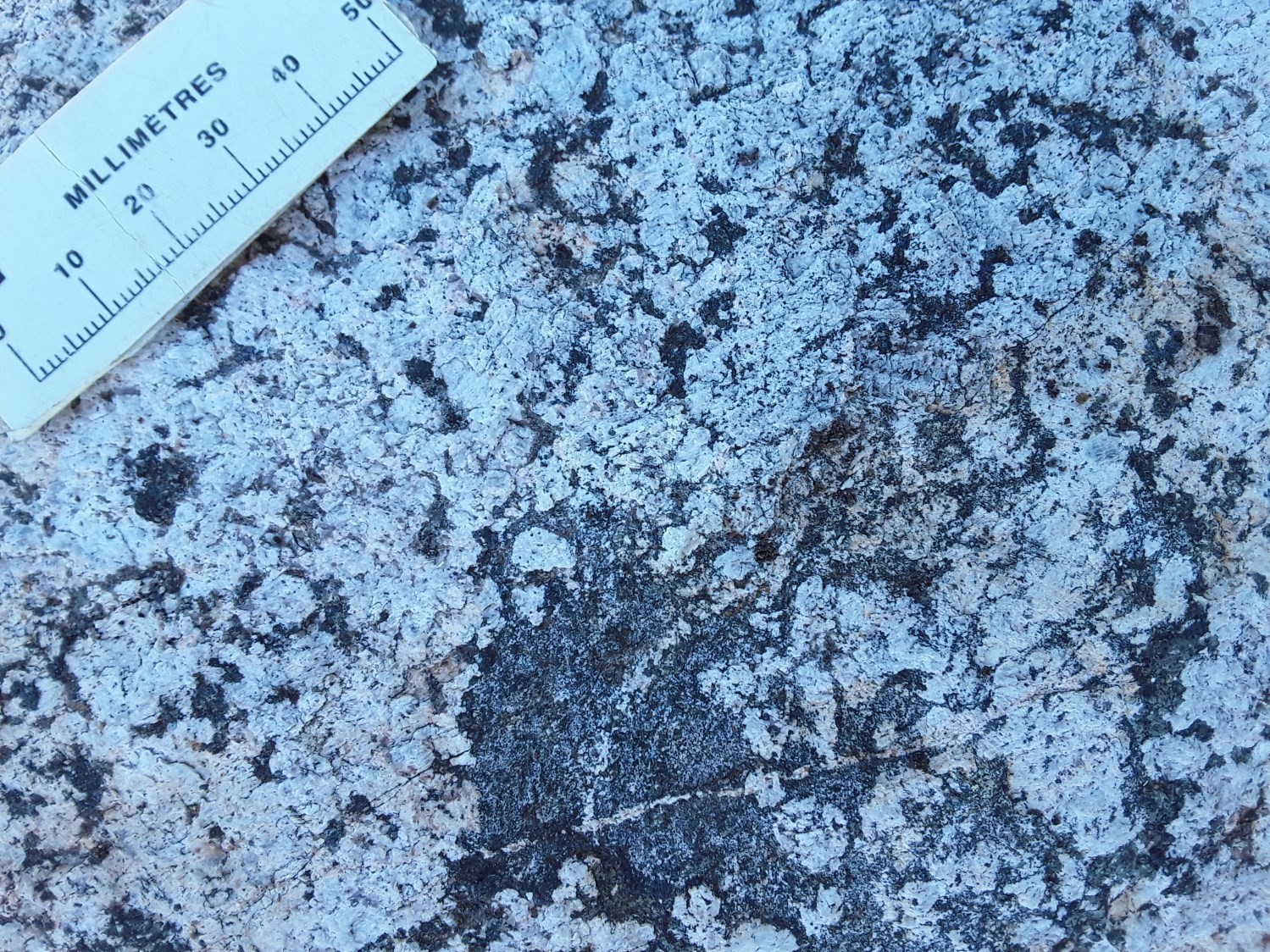
 The mangerite (hypersthene quartz monzonite; e.g., outcrop 2021-AM-043) is rust brown in alteration patina and grey-green in fresh surface. It is characterized by a coarse, porphyroid grain size with phenocrysts of plagioclase and potassium feldspar (35-40% of the rock, 1-3.5 cm in length), locally with rapakivi structure. It shows little deformation. It is composed of large patches of quartz, perthitic potassium feldspar, strongly sericitized plagioclase, clinopyroxene, orthopyroxene, hornblende and magnetite. Orthopyroxene is present in inclusions in the plagioclase phenocrysts where it is bordered by green hornblende. The proportion of orthopyroxene and clinopyroxene varies in outcrop (2 to 8%). Ferromagnesian minerals (pyroxenes and hornblende) form clusters of a few millimetres here and there in the rock. Accessory minerals consist of apatite and zircon. Mangerite is cut by diorite dykes (1 to 2 m wide) and also contains enclaves of this fine-grained grey diorite. Locally, the dioritic dyke is in turn injected by veins and veinlets of mangerite and contains enclaves of mangerite as well.
The mangerite (hypersthene quartz monzonite; e.g., outcrop 2021-AM-043) is rust brown in alteration patina and grey-green in fresh surface. It is characterized by a coarse, porphyroid grain size with phenocrysts of plagioclase and potassium feldspar (35-40% of the rock, 1-3.5 cm in length), locally with rapakivi structure. It shows little deformation. It is composed of large patches of quartz, perthitic potassium feldspar, strongly sericitized plagioclase, clinopyroxene, orthopyroxene, hornblende and magnetite. Orthopyroxene is present in inclusions in the plagioclase phenocrysts where it is bordered by green hornblende. The proportion of orthopyroxene and clinopyroxene varies in outcrop (2 to 8%). Ferromagnesian minerals (pyroxenes and hornblende) form clusters of a few millimetres here and there in the rock. Accessory minerals consist of apatite and zircon. Mangerite is cut by diorite dykes (1 to 2 m wide) and also contains enclaves of this fine-grained grey diorite. Locally, the dioritic dyke is in turn injected by veins and veinlets of mangerite and contains enclaves of mangerite as well.
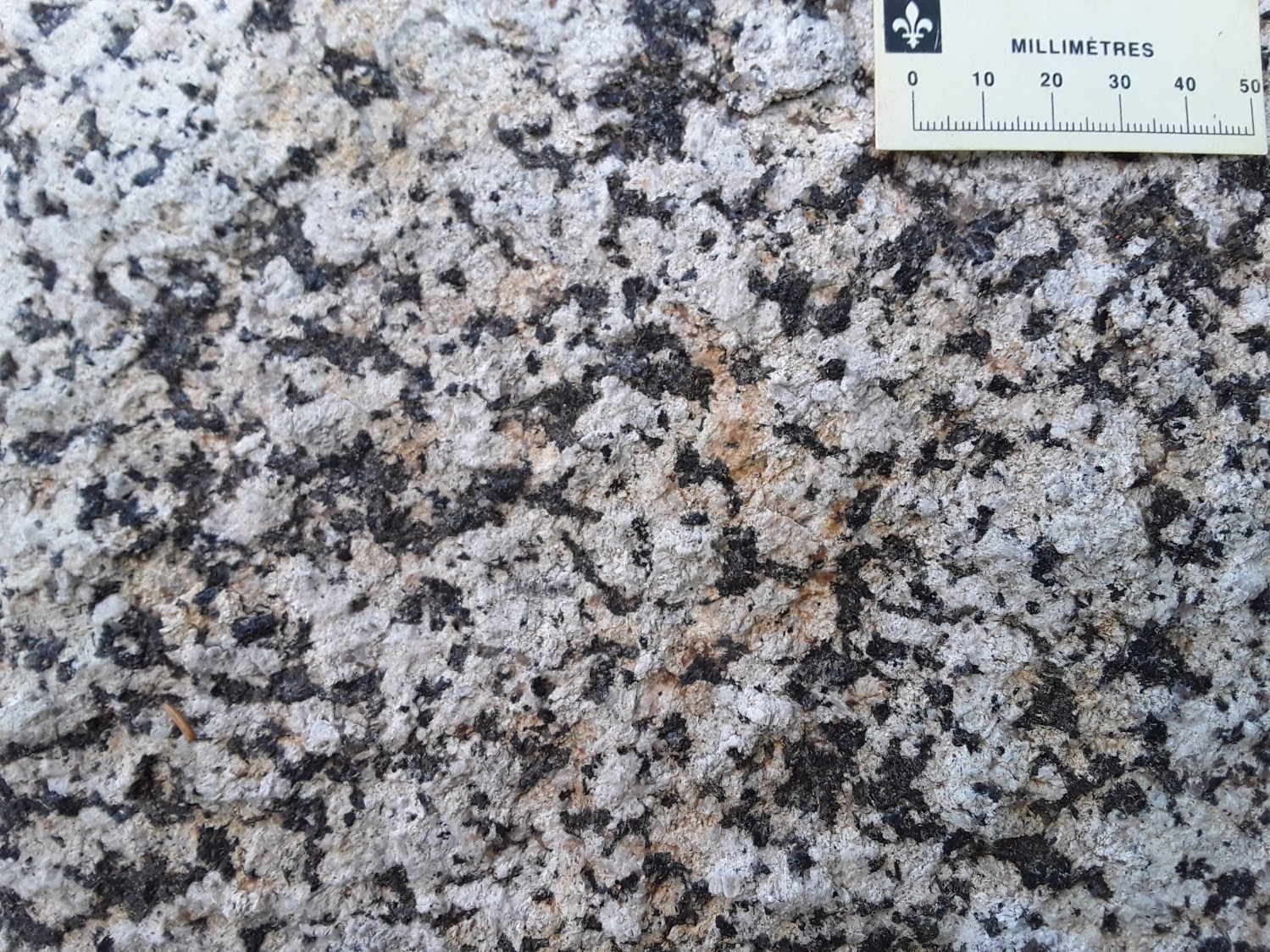 The hypersthene syenite (e.g., outcrop 2021-ME-1030) is white-grey in alteration patina and grey-green in fresh surface, medium to coarse grained, granoblastic, locally porphyroid with potassium feldspar phenocrysts and lightly deformed. Porphyroid phases show up to 60% of feldspar phenocrysts, 1-3 cm in length (e.g., outcrop 2021-AM-39). It consists of orthopyroxene, potassium feldspar, plagioclase, clinopyroxene, biotite, magnetite, hornblende and quartz. The latter varies and can reach 20% in the rock, which then becomes a hypersthene quartz syenite. Under the microscope, the majority of potassium feldspar is perthitic and plagioclase is sericitized. Green hornblende forms clusters in association with orange-red biotite and small inclusions of quartz and magnetite. Quartz is generally in large patches and shows an undulatory extinction. Accessory minerals are represented by allanite and zircon. Ferromagnesian minerals (pyroxenes, hornblende and biotite) form clusters of a few millimetres in places in the rock.
The hypersthene syenite (e.g., outcrop 2021-ME-1030) is white-grey in alteration patina and grey-green in fresh surface, medium to coarse grained, granoblastic, locally porphyroid with potassium feldspar phenocrysts and lightly deformed. Porphyroid phases show up to 60% of feldspar phenocrysts, 1-3 cm in length (e.g., outcrop 2021-AM-39). It consists of orthopyroxene, potassium feldspar, plagioclase, clinopyroxene, biotite, magnetite, hornblende and quartz. The latter varies and can reach 20% in the rock, which then becomes a hypersthene quartz syenite. Under the microscope, the majority of potassium feldspar is perthitic and plagioclase is sericitized. Green hornblende forms clusters in association with orange-red biotite and small inclusions of quartz and magnetite. Quartz is generally in large patches and shows an undulatory extinction. Accessory minerals are represented by allanite and zircon. Ferromagnesian minerals (pyroxenes, hornblende and biotite) form clusters of a few millimetres in places in the rock.
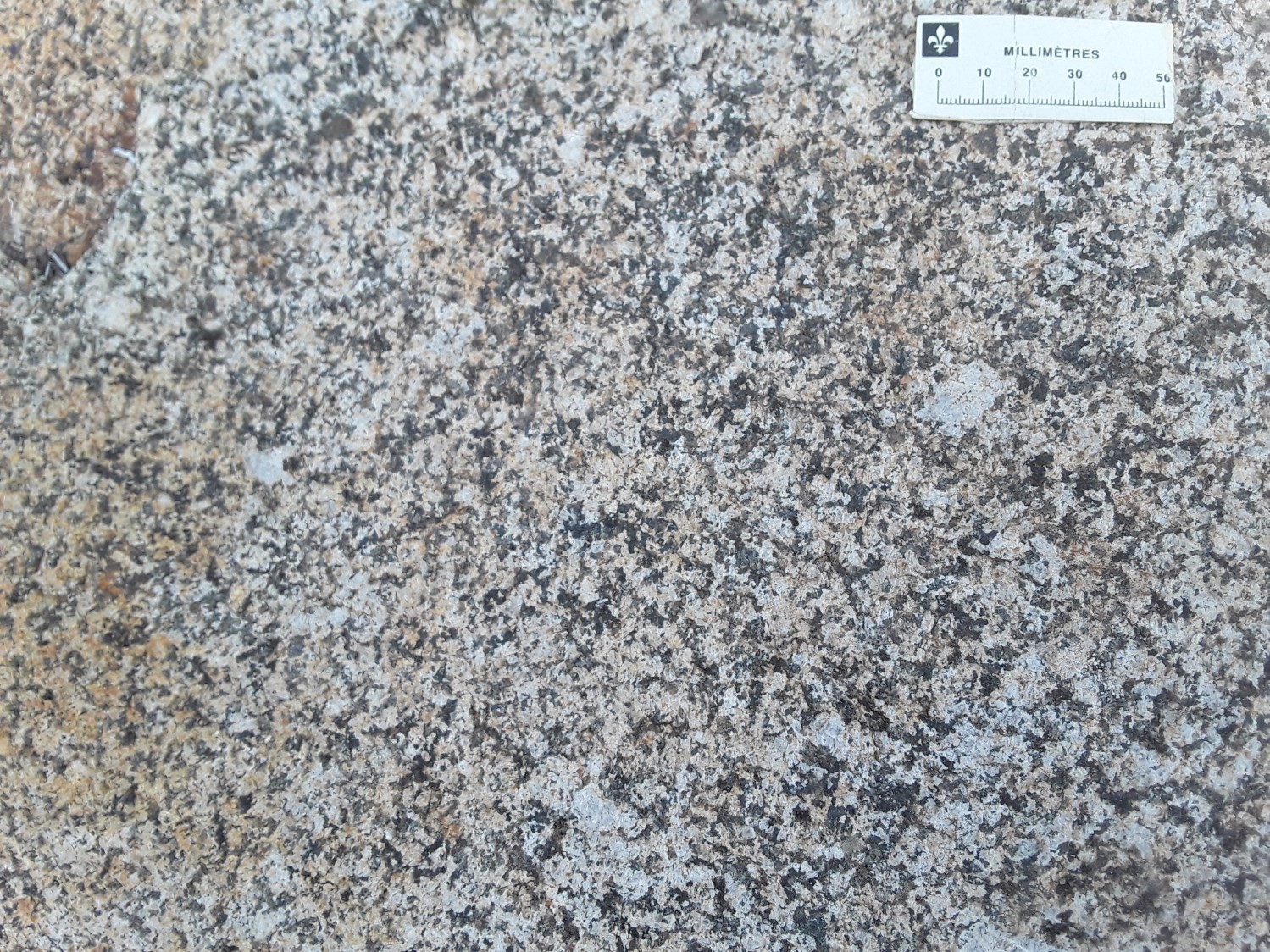 The quartz monzodiorite is greyish to rust brown in alteration patina, green-black in fresh surface, medium to coarse grained, locally porphyroid with plagioclase phenocrysts and lightly deformed. It consists of quartz, magnetite, clinopyroxene, plagioclase, potassium feldspar, biotite and orthopyroxene. The proportion of orthopyroxene is variable in outcrop and can constitute 1-6% of the rock (e.g., outcrop 2021-AM-45). Under the microscope, biotite has an orange-red hue and is associated with magnetite and orthopyroxene grouped in millimetre-sized clusters. Accessory minerals are apatite, titanite and zircon.
The quartz monzodiorite is greyish to rust brown in alteration patina, green-black in fresh surface, medium to coarse grained, locally porphyroid with plagioclase phenocrysts and lightly deformed. It consists of quartz, magnetite, clinopyroxene, plagioclase, potassium feldspar, biotite and orthopyroxene. The proportion of orthopyroxene is variable in outcrop and can constitute 1-6% of the rock (e.g., outcrop 2021-AM-45). Under the microscope, biotite has an orange-red hue and is associated with magnetite and orthopyroxene grouped in millimetre-sized clusters. Accessory minerals are apatite, titanite and zircon.
The alkali feldspar granite is fine to coarse grained, pink in alteration patina, pink-grey in fresh surface, and moderately deformed. Some occurrences of alkali feldspar granite in this unit are porphyroid with feldspar phenocrysts (e.g., 2021-ME-1143). The rock is locally hematitized and composed of quartz, potassium feldspar, plagioclase, magnetite and orthopyroxene.
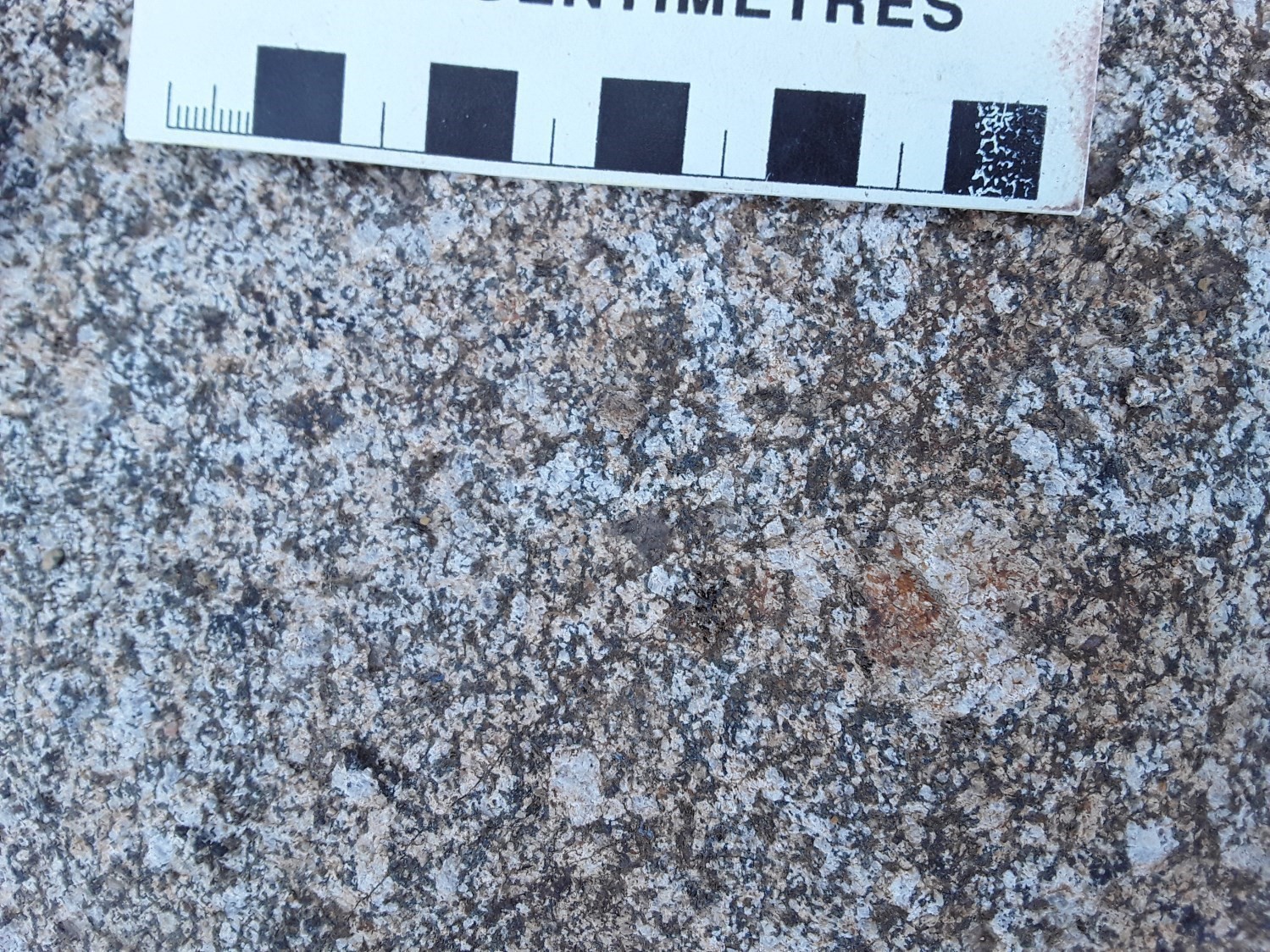 In this informal unit, gabbronorite is in smaller proportion, rust brown in alteration patina and green-black in fresh surface. It is generally coarse grained, granoblastic, locally porphyroid in plagioclase and contains xenocrysts of potassium feldspar (e.g., outcrop 2021-AM-44). These were probably stripped from the syenite and/or mangerite of this same suite during the emplacement of the gabbronorite. The latter has a discrete compositional bedding and is composed of plagioclase, orthopyroxene, magnetite, biotite, clinopyroxene, apatite, ilmenite and traces of amphibole and sulphides (pyrite, pyrrhotite).
In this informal unit, gabbronorite is in smaller proportion, rust brown in alteration patina and green-black in fresh surface. It is generally coarse grained, granoblastic, locally porphyroid in plagioclase and contains xenocrysts of potassium feldspar (e.g., outcrop 2021-AM-44). These were probably stripped from the syenite and/or mangerite of this same suite during the emplacement of the gabbronorite. The latter has a discrete compositional bedding and is composed of plagioclase, orthopyroxene, magnetite, biotite, clinopyroxene, apatite, ilmenite and traces of amphibole and sulphides (pyrite, pyrrhotite).
Centimetric to metric leuconorite enclaves are locally present at the western border of this unit (outcrop 2021-AM-83). The leuconorite has a few areas that contain only plagioclase crystals (anorthosite). The leuconorite is foliated and locally pegmatitic with large orthopyroxene crystals. The enclaves may be derived from the Lac-Saint-Jean Anorthositic Suite which outcrops west of the contact with the Tommy Intrusive Suite.
Thickness and distribution
The shape of the Tommy Intrusive Suite is reminiscent of a ~210 km² heart. It is located between Grand Lac Brochet and Rats Lake (western part of sheet 32H01 and eastern part of sheet 32H02).
Dating
None.
Stratigraphic Relationship(s)
The Tommy Intrusive Suite is intrusive in the Sainte-Hedwidge Intrusive Suite and in the Lac-Saint-Jean Anorthositic Suite. It is cut by a carbonatite dyke which is likely post-Grenvillian. The contact between the mPtmm1 unit and its host rock is faulted and consists of a shear zone of dextral movement. Berrangé (1960) noted, during his mapping of sheet 32H01, the presence of metric to kilometric enclaves of migmatitic paragneiss (Barrois Complex) and amphibolite in the Tommy Intrusive Suite.
Paleontology
Does not apply.
References
Publications available through SIGÉOM Examine
BERRANGE, J. P., 1960. RAPPORT PRÉLIMINAIRE SUR LA RÉGION D’ANTOINE, DISTRICT ÉLECTORAL DE ROBERVAL. MRN; RP 429, 15 pages, 1 plan.
EL BOURKI, M., MOUKHSIL.A. 2021. Géologie de la région de Dolbeau-Blondelas, Province de Grenville, région du Saguenay–Lac-Saint-Jean, Québec, Canada. MERN; BG 2022-02, 1 plan.
INTISSAR, R., BENAHMED, S., 2015. Levé magnétique aéroporté dans le secteur ouest du Lac-St-Jean, Province de Grenville. MERN, GOLDAK AIRBORNE SURVEYS; DP 2015-06, 7 pages, 2 plans.
Suggested Citation
Ministère de l’Énergie et des Ressources naturelles (MERN). Tommy Intrusive Suite. Quebec Stratigraphic Lexicon. https://gq.mines.gouv.qc.ca/lexique-stratigraphique/province-de-grenville/suite-intrusive-de-tommy_en [accessed on Day Month Year].
Contributors
|
First publication |
Abdelali Moukhsil, P.Geo., Ph.D. abdelali.moukhsil@mern.gouv.qc.ca; Mhamed El Bourki, GIT, M.Sc. mhamed.elbourki@mern.gouv.qc.ca (redaction) Mehdi A. Guemache, P.Geo., Ph.D. (coordination); Fabien Solgadi, P.Geo., Ph.D. (critical review); Simon Auclair, P.Geo., M.Sc. (editing); Catherine Tremblay (English version). |

